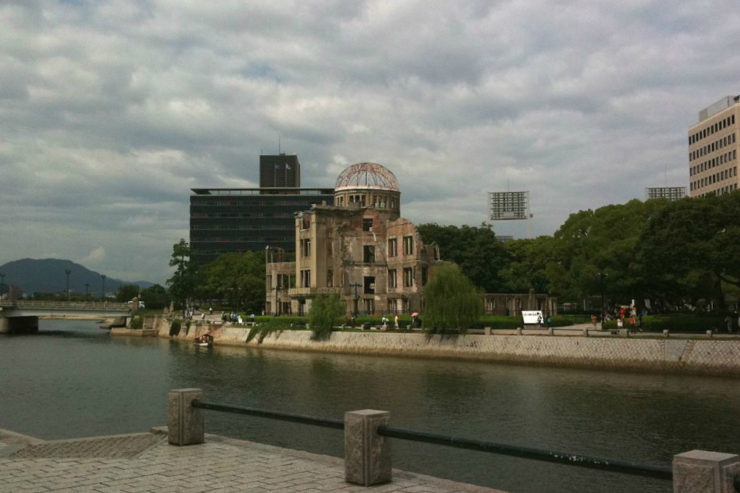Yes to a culture of peace, no to the nuclear, is how Monsignor Paul Richard Gallagher’s message can be summarized, who is concluding a one-week visit to Japan, in the course of which he met with Prime Minister Shinzo Abe. He gave a conference at the University of Tokyo and celebrated Mass at Hiroshima, reported Vatican Radio in English, affirming that the Vatican’s Secretary for Relations with States confirmed the Holy See’s cooperation with Japan regarding the elimination of nuclear weapons. Wednesday, February 1, Monsignor Gallagher held a “Lectio Magistralis” on the theme of the promotion of a culture of peace at the Jesuit-run University of Sophia in Tokyo. He evoked the important contribution made by this Catholic University, which takes into account a global and not merely intellectual formation of the whole person.
Quoting Pope Francis’ words, he said: “If the university becomes no more than an academy of ideas or an assembly line of professionals, or its structure is determined by a business mentality, then it has truly lost its way.”
One must never tire of looking at the world, with its events and actors, critically but also constructively, asking not to “exclude” and appealing for “necessary dialogue” as a method proper to cultural and educational processes, recommended Monsignor Gallagher.
For him, “the question of peace involves more than politics or diplomatic activity; it is directly linked to culture and to the sphere of ethics and moral conscience that can generate much apprehension, yet is so greatly needed in international relations.
The “vision of peace proposed by the magisterium of the Catholic Church does not necessarily coincide with that current in the community of the nations, as summarized, for example, by the contents of the UN Charter. The difference does not simply have to do with issues involving the use of force or the obligations incumbent upon States, but with the conviction that peace calls first and foremost for preventing the causes that lead to war,” he said.
However, “to bring true peace, it is necessary to bring people together concretely so as to reconcile peoples and groups with opposing ideological positions. It is also necessary to work together for what persons, families, peoples and nations feel is their right, namely, to participate on a social, political and economic level in the goods of the modern world.” Thus, for Monsignor Gallagher, peace on earth is the result of numerous factors, of which the “culture of peace” is the vehicle.
He recalled that Pope Francis speaks of “a war being fought piecemeal” as a way of perceiving, among the many possible causes of conflict (selfish interests, poverty, lack of development, territorial dominion, spheres of influence …) the one that is essential.
Working for peace, he stressed, demands returning to the bases of human relationships and thus recovering the bases of the internal order of nations and the international order.
“As Pope Francis sees it, this means that true peace cannot come about ‘without the recognition of certain incontestable natural ethical limits and without the immediate implementation of those pillars of integral human development.’” A true culture of peace, then, calls for concrete commitments requiring solid and structured foundations: exactly the opposite of the frequently heard idea that a single theoretical and aprioristic solution will provide an answer to all the challenges,” noted again the Holy See’s “Foreign Affairs Minister.”
Monsignor Gallagher has tools that are at the disposition of the planet’s leaders: he spoke of the culture of peace and the threat against peace, which today “comes not only from traditional wars and hostilities, whether domestic or international, but also from other problems.”
He evoked the need to return to the vision of a just peace, which includes religious freedom in its varied forms, among which is conscientious objection and pointed out that a culture of peace can also make a huge contribution to anti-terrorism strategies, reported Vatican Radio.
Monsignor Gallagher also mentioned the goals to be achieved: the use of dialogue, discussion and negotiation as well as “the language of the magisterium, this involves a correct and consistent application of the principle of subsidiarity.”
He reflected on the areas of development and international cooperation, on the more general fight against poverty, which “presupposes a common agreement that can only be the result of an effective solidarity between States.”
He added that “this would involve a greater appreciation of the role of intellectual property, an area in which a consistent culture of peace is called to recognize the right of researchers and producers to just compensation, so that new developments can truly be at the service of the common good of the human family.”
The same source pointed out that Monsignor Gallagher concluded calling for a “prophetic vision that can bring together the human, cultural and religious aspects and thus offer our contemporary world a firm common witness to the service of goodness, the service of dialogue and the service of peace. In this context, the university has a fundamental task as a place of encounter between faith and reason, between memory of the past and scientific development towards the future, and as a place of encounter and discussion between different vision of life, technology, politics and religious convictions. That task is to prepare the way for a future of peace, an attainable future, a future for all.”

Hiroshima Peace Memorial / Wikimdia Commons - IPhone修理/カスタマイズパーツ販売…, CC BY 3.0 (Cropped)
Japan: Yes to a Culture of Peace, No to the Nuclear, says Monsignor Gallagher
For Integral Human Development


